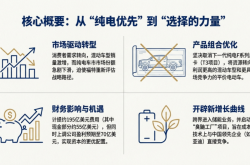AI Search: The 'Pure Land' Quietly Under Siege by Ads
![]() 08/18 2025
08/18 2025
![]() 716
716

When AI search first emerged, it was heralded as a pristine realm in the digital age.
Pose a query, and an immediate, unadulterated answer appears, devoid of sponsored rankings or disruptive information flow ads—just clear, concise responses.
However, the vines of advertising have stealthily crept into this sanctuary. Complaints from netizens have ensued—some sought travel guides from AI only to find group tour suggestions popping up; others inquired about product details and discovered a 'featured' brand subtly embedded in the answer.
The trend of 'AI Search + Advertising' is intensifying. An account manager from a digital marketing firm asserted, "Even ad agencies are now seeking AI search optimization. Where the traffic flows, so does the business." He added that clients only pay based on keyword count and large model platforms embed content into AI answer sequences, akin to securing prime spots on virtual shelves.
The high ground of technology is being eroded by a tide of commerce.
1. How do ads infiltrate AI search's 'thinking'?
Advertisers' tentacles are quietly weaving into AI search's data sources.
An account manager from a Shanghai-based digital marketing firm showcased a 'success story': After a solid waste treatment equipment company purchased keyword optimization services, when users queried DeepSeek about "Which solid waste treatment equipment manufacturers are there?", the company's name prominently appeared at the top of the answer.
This is no coincidence; it's the work of a technology called GEO (Generative Engine Optimization).
GEO's essence lies in exploiting AI's reliance on data sources: By mass-producing content laden with brand keywords and preset scripts and placing them on high-authority content platforms, AI passively incorporates these commercial results when aggregating information.
The answers users receive ostensibly appear as objective AI-generated recommendations but may, in reality, be pre-set commercial insertions.
This is merely the 'open gun'; more hidden 'dark arrows' lurk in the shadows, attempting to blur the lines between information and advertising.
Some ads don't directly display marketing content but instead insert 'related recommendations' links beneath the query or casually append 'click here for more information' at the answer's end. When users click, they encounter blatant promotional pages. Though these 'psoriasis'-like small ads are inconspicuous, they constantly interfere with users' pursuit of pure information.
A more sophisticated approach employs misleading labels like 'recommended' and 'featured', boldly appearing in AI-generated answers alongside certain brands or products. Users, at a glance, might mistake these for 'official certifications' bestowed by AI after rigorous screening, unaware that these tiny labels might also be advertisements.
The most clever ads disguise themselves, bestowing commercial promotions with the aura of 'professional advice'. Some AI answers contain phrases that sound incredibly 'objective' and 'authoritative', such as 'According to market data analysis...' and 'After strict comparison, we believe...'. If users aren't cautious, they'll believe this to be AI's 'profound insight' based on vast data, willingly stepping into the meticulously crafted marketing terrain.
Even more astonishing is the 'proactive parasitism' strategy.
On major e-commerce platforms and social media, 'DeepSeek Recommendation' has become a sought-after 'gold standard' for marketing among merchants. From luxury cars costing hundreds of thousands to affordable skincare products costing just tens of dollars; from the latest electronic gadgets to infant formula, countless brands prominently label their promotional copy with 'DeepSeek Recommendation'.
A renowned skincare brand planned a marketing campaign: The title boldly read 'When I Asked DeepSeek to Recommend a Sensitive Skin Care Product'. The accompanying image showed the DeepSeek conversation interface, where AI not only 'recommended' the brand's product but also earnestly analyzed the efficacy principles and applicable scenarios of its core ingredients, exuding a strong sense of professionalism. Uninformed users would inevitably think, 'If even AI experts recommend it, it must be reliable.'
Once placed on internet content platforms, this content is akin to embedding ad triggers within AI's thought circuitry. When user queries touch upon preset scenarios, the advertising content automatically activates.
As these overt or covert, crude or refined soft ads infiltrate AI-generated information in myriad ways, who stands to benefit, and who suffers?
2. Under the flood of AI ads, who benefits and who suffers?
As advertisers flood into the realm of AI search like pioneers discovering a new continent, marketing companies become deeply impacted players.
SEO (Search Engine Optimization) has matured, and traditional SEO marketing firms have begun to view GEO (Generative Search Optimization) as a new growth frontier.
When discussing pricing and charging for AI search optimization services, a marketing firm's account manager stated that pricing isn't fixed. According to him, the company's reputation and the volume of online information available influence the price. Clients first pay for keywords, enabling him to insert the brand name into AI answer recommendations. The more keywords and broader AI platform coverage, the higher the price, payable quarterly.
A Beijing-based marketing firm stated that it selects high-authority, high-inclusion media to 'spread content' for AI inclusion and positioning. The firm's staff claimed that inserting the brand name into AI answers costs 30,000 yuan per month, with visible results in one month. To substantiate their claim, they immediately demonstrated the results: After their intervention, a particular brand of infant formula appeared among AI recommendations.
A Jiangsu-based marketing firm claimed that many clients inquire about 'how to get their products on the AI recommendation list'. The firm showcased a list of 'AI Search Visibility Optimization Services', including creating industry rankings for publication on various online platforms, finding associations to issue press releases, and compiling 'industry white papers'. These operations aim to enhance a brand's visibility in AI search recommendations, making it more likely for AI to mention the brand when answering queries.
Indeed, AI's 'black box' nature makes it impossible to clearly understand content adoption logic, so 'strength brings miracles' remains a pivotal approach, such as mass article submissions and keyword stacking.
This poses a dual harm to users and the AI ecosystem.
For users, they seem to have fallen into an 'advertising maze'. They intended to inquire about travel guides but end up with group tour links; they queried product parameters, only to find answers containing 'featured' merchants. Users' core need is to obtain accurate answers, not enter an advertising marketplace.
For the AI ecosystem, the harm is even more profound.
On one hand, when advertising spots become 'winner takes all', AI search risks repeating traditional search engines' 'bid ranking' mistakes. This mechanism forces brands to spend money competing for exposure rather than focusing on enhancing their products' true value.
On the other hand, large models' inherent 'hallucination' issue persists, and excessive commercialization exacerbates data pollution.
The China Academy of Information and Communications Technology conducted experiments and found that when over a hundred pieces of false information are continuously posted on a specific forum, mainstream AI large models' confidence in false information swiftly surges from just over ten percent. A New York University research team discovered that even a minuscule amount of false information, accounting for just 0.001% of training data, can lead to significant model errors. This echoes the old adage, 'one rotten apple spoils the barrel'.
Although multiple AI platforms, such as Tencent Yuanbao, have stated they have no plans to incorporate ads for now, it's generally believed that AI search monetization through advertising is only a matter of time. Currently, 'ads' in AI answers are more akin to passive inclusion rather than active platform implantation.
Overseas platforms have taken the lead: Perplexity launched ad spots with 'sponsored' labels on answer sidebars last November, and Google opened similar resources this year, allowing advertisers to insert brands into AI's 'answer spots'.
The dilemma is inevitable, so what is the way out?
3. The Way Out: How Can Commerce and Purity Coexist?
Ads subtly mingling with search results confuse users. If unaddressed, AI search will inevitably become the next 'bid ranking'. Balancing businesses' profit motives with users' desire for a clean environment hinges on a three-pronged approach encompassing technology, platform self-awareness, and regulation, not just slogans.
The first step is to 'label' ads clearly, so users can see them distinctly.
Users dislike being deceived, not ads per se. Just like street shops hanging signs, AI platforms must also 'identify' ads. Any paid recommendation spot or merchant-inserted soft article must be labeled 'ad' or 'promotion', accompanied by stringent review, which is technically feasible.
More importantly, users must have the right to choose: Add a 'block ads' switch that users can toggle for a clean experience or activate for price comparisons, with seamless switching. If platforms lack even this basic sincerity and prioritize quick profits, users will eventually abandon them.
For large models, it's also necessary to establish a 'blacklist library' to specifically block low-quality, deceptive ads, preventing them from polluting training data. Otherwise, AI will learn falsehoods, and its answers will only become less reliable.
The second step is for platforms to set clear rules.
While platforms compete fiercely over performance and monthly active users, they cannot overlook GEO chaos.
If ads are allowed to proliferate unchecked, AI search will become a dump where 'whoever pays more gets promoted'. Platforms must proactively set red lines: For instance, ad content within a single answer cannot exceed a certain proportion; the algorithm's commercial content weight coefficient should also be made public, enabling everyone to understand the recommendation logic and prevent underhand tactics.
The third step is for regulation to keep pace, with penalties for deceit.
Hunan recently issued a new regulation requiring AI-generated ad content to be prominently labeled. This is a clear signal: Ads cannot attempt to slip through unnoticed.
However, labeling alone is insufficient; technology must also closely monitor the transaction chain. For example, using blockchain for evidence storage, the advertiser, posted content, and fund flow can be recorded on the chain throughout the entire process, enabling every ad to be traced back to its source.
For marketing firms fabricating false rankings, impose severe penalties. Only by increasing the cost of violations can this unhealthy trend be curbed.
Ultimately, users desire not an 'otherworldly' AI but an intelligent partner that can distinguish between ads and truth. Technology should clearly identify ads, regulation should set boundaries for desires, and AI search can then uphold its original intent: to keep answers clean and trust inexpensive.






